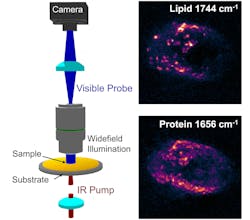IR chemical imaging method promises better prostate cancer examination
Recognizing that the current procedure for prostate cancer examination lacks precision, a team of researchers at Purdue University and collaborators from Boston University (Boston, MA) and the Chinese Academy of Sciences (Beijing, China) has developed an infrared (IR) chemical imaging method that could enable improved microscopic studies of tissue to detect what is there and cut down on unnecessary surgeries.
"The current examination isn't precise, so there's a lot of surgery because doctors can't tell when there's a large amount of cancer, whether it's aggressive or benign," explains Ji-Xin Cheng, adjunct professor of Purdue's Weldon School of Biomedical Engineering and the Department of Chemistry, as well as the Moustakas Chair Professor of Photonics at Boston University (Boston, MA), who led the development. "This new method would allow the detection of aggressive breast, prostate, and other cancers with biomarker information and at submicron spatial resolution," he says.
The proposed method offers a much quicker examination of cells and tissues and allows for a larger area mapping, which is important to determine biomarker information. Cheng says finding markers to determine a cancer’s aggressiveness has been a goal throughout the research. This method allows the examination of living cancer cells rather than drying out the sample to enable study using traditional IR spectroscopy.
The research team's journal paper describes shining both an IR excitation laser and another visible probe laser through a sample and measuring the difference between the hot and cold states. Photothermal detection is used to improve the spatial resolution by one order of magnitude compared to traditional IR microscopy, providing an opportunity to look for the various biomarkers within the cells.
Cheng and collaborator Ali Shakouri, the Mary Jo and Robert L. Kirk Director of the Birck Nanotechnology Center in Purdue's Discovery Park, used a lock-in camera that was fast enough to handle the million pixels per second in parallel. Shakouri, inventor of the lock-in camera, says the camera detects very small changes in light coming into it.
The research builds on work by Cheng and colleagues published in 2016 in the journal Science Advances. Previous imaging needed 8 seconds per image, which is considered too slow by Cheng because cells and molecules are in constant motion. Future research will include work to increase the field of view so that the size of the sample that can be examined can be as large as a few millimeters.
Cheng also wants to push the sensitivity to detect very small particles like a single virus or a single bacterium. The latter can allow faster detection of bacterial response to antibiotics.
"Current medical practice is to spend 1-2 days to culture a specimen, then a doctor can tell you if you if you have an infection or not," Cheng says. "But if we can measure that at a single bacterium level, that's a rapid detection. That will be a very important application of this platform."
Full details of the latest work also appear in the journal Science Advances.
